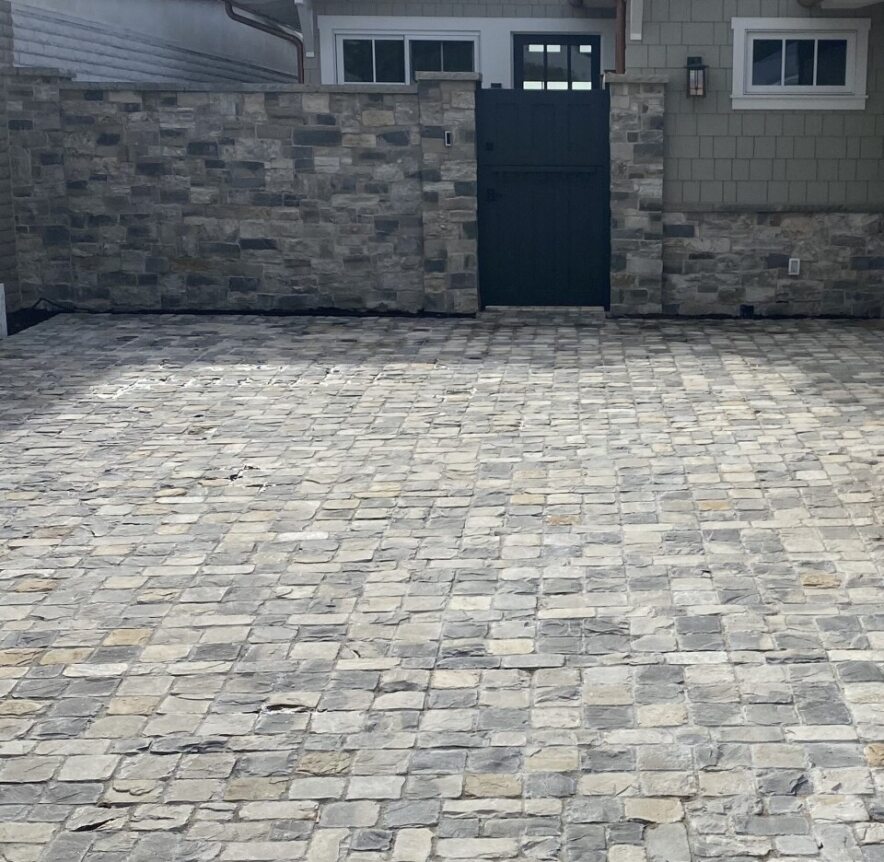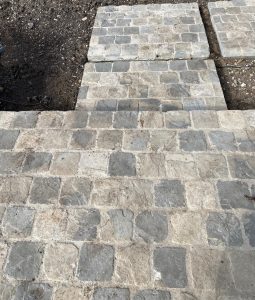Cobblestone pavers are a timeless and elegant choice for driveways, walkways, patios, and outdoor spaces. Known for their durability and classic aesthetic, cobblestones provide a high-end look while withstanding heavy foot and vehicle traffic. Installing cobblestone pavers requires careful planning, proper material selection, and attention to detail to ensure a long-lasting and visually appealing result.
This guide will walk you through every step of installing cobblestone pavers, from preparation to final sealing, helping you create a stunning outdoor space in 2025.
Why Choose Cobblestone Pavers for Your Outdoor Space?
When deciding on a paving material, cobblestone pavers stand out for their unique advantages and timeless charm.

The Benefits of Cobblestone Pavers
Cobblestone pavers offer several benefits, including:
- Durability: Naturally resistant to wear, weather, and heavy loads.
- Low Maintenance: Requires minimal upkeep compared to concrete or asphalt.
- Aesthetic Appeal: Enhances property value with its old-world elegance.
- Eco-Friendly: Allows for natural water drainage, reducing runoff and erosion.
These advantages make cobblestone pavers an excellent choice for both residential and commercial spaces.
Ideal Applications for Cobblestone Pavers
Cobblestones work well in various outdoor applications, including:
- Driveways – Withstand vehicle traffic while maintaining a polished look.
- Walkways and Paths – Add charm and functionality to garden paths.
- Patios – Create a luxurious outdoor seating area.
- Borders and Accents – Define edges of flower beds or paved areas.
Now that you understand why cobblestone pavers are a great choice, let’s move on to the installation process.
Preparing for Cobblestone Paver Installation
Proper preparation is key to a successful and long-lasting cobblestone paver installation.
Gathering Materials and Tools
Before you start, ensure you have the following materials and tools:
- Cobblestone pavers (choose high-quality natural stone from Lompoc Stone)
- Gravel or crushed stone base
- Sand for bedding
- Edging restraints
- Rubber mallet
- Masonry saw (if cutting is required)
- Plate compactor
- Level and measuring tape
- Polymeric sand (for sealing joints)
Having the right materials ensures a smoother installation process.
Measuring and Planning the Layout
Carefully measure the area where you will install cobblestone pavers. Mark the boundaries with stakes and string lines to create a clear visual guide. Consider the pattern you want to use—common patterns include fan, running bond, and basket weave.
Planning ahead helps prevent misalignment and ensures a professional-looking installation.
Step-by-Step Guide to Installing Cobblestone Pavers
The installation of Lompoc Stone cobblestone pavers involves several critical steps to achieve a durable and visually appealing surface. Since these 1-3/4″ thick cobbles require a concrete base, this guide outlines the proper method to ensure long-lasting stability.
Excavating and Preparing the Base
Start by excavating the area to the appropriate depth, typically 6–8 inches for walkways and 10–12 inches for driveways. Unlike thicker, 4-inch cobbles (which are special order only at Lompoc Stone), the 1-3/4″ cobbles must be laid over a concrete base, not on a traditional gravel and sand foundation.
Once the area is excavated, compact the soil using a plate compactor to create a solid base. Next, pour a 4–6 inch concrete slab, ensuring the surface is level and smooth. Allow the concrete to cure fully before proceeding to the next step. On top of the concrete base, apply a 1-inch layer of sand to provide a smooth bedding surface for the cobblestone pavers. The sand helps level the pavers and facilitates minor adjustments during installation.
Laying the Cobblestone Pavers
Begin placing the cobblestone pavers directly on the prepared concrete base with the sand layer. Arrange the stones in your chosen pattern, ensuring each paver fits snugly against the next to avoid gaps. Use a rubber mallet to gently tap the stones into place, maintaining a level surface.
Regularly check the alignment of the pavers, making adjustments as needed to preserve the pattern and create a uniform look. If pavers need to be cut to fit edges or corners, use a masonry saw to achieve clean and precise cuts. This method not only enhances the aesthetics of the installation but also reinforces the integrity of the cobblestone surface.
Securing and Finishing the Cobblestone Paver Surface
Once all the cobblestone pavers are laid, securing and sealing them is essential for long-term durability.

Installing Edging Restraints
Edging restraints prevent pavers from shifting over time. Secure them along the perimeter using spikes or concrete edging. This step ensures the integrity of your paved area.
Filling the Joints and Compacting the Surface
Sweep polymeric sand into the joints between the cobblestone pavers. This helps lock the pavers in place and prevents weed growth. After filling the joints, use a plate compactor to settle the pavers and sand further.
Once compacted, lightly mist the surface with water to activate the polymeric sand, ensuring a strong bond.
Maintaining Your Cobblestone Paver Installation
Proper maintenance extends the lifespan of cobblestone pavers and keeps them looking pristine.
Regular Cleaning and Weed Prevention
To maintain your pavers:
- Sweep debris regularly to prevent buildup.
- Use a mild detergent and water to clean stains.
- Apply weed-prevention treatments to keep joints clear.
Resealing and Repairing Pavers
Over time, sealing your cobblestone pavers can enhance their appearance and protect against wear. Inspect for any loose stones and reset them if necessary.
Alternative Installation Techniques for Cobblestone Pavers
Different techniques can be used depending on your project needs.
Mortar-Set vs. Dry-Laid Installation
- Dry-laid method – Uses a sand and gravel base for flexibility and drainage.
- Mortar-set method – Involves setting stones in concrete for a permanent, rigid structure.
Each method has advantages, with the dry-laid method being more adaptable and the mortar-set method offering extra durability.
Permeable Cobblestone Paver Installations
Permeable installations allow water to pass through the joints, reducing runoff and improving drainage. This eco-friendly method is ideal for driveways and patios in regions with heavy rainfall.
FAQs
1. How long do cobblestone pavers last?
Cobblestone pavers can last for decades, often over 50 years, with proper installation and maintenance.
2. Are cobblestone pavers suitable for driveways?
Yes, they are highly durable and can withstand vehicle traffic, making them ideal for driveways.
3. Do I need to seal cobblestone pavers?
Sealing is optional but recommended for added protection against stains and weather damage.
4. What is the best base for cobblestone pavers?
A compacted gravel base with a sand layer provides a solid foundation for long-term stability.
5. Where can I buy high-quality cobblestone pavers?
Visit Lompoc Stone for premium natural stone pavers designed for durability and elegance.
Conclusion
Installing cobblestone pavers is a timeless way to enhance the beauty and functionality of your outdoor space. With proper planning, high-quality materials, and careful installation, you can create a durable and elegant surface that lasts for decades.
At Lompoc Stone, we provide premium cobblestone pavers sourced from natural stone quarries, ensuring superior durability and aesthetics. Get a quote from us and start your next paving project!






